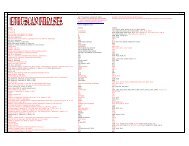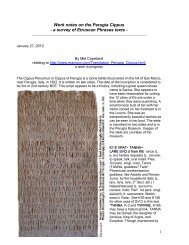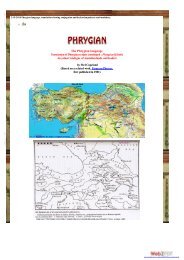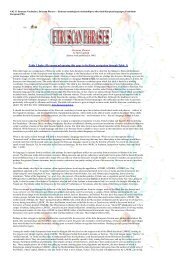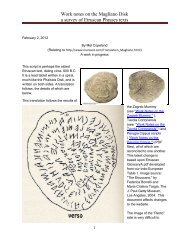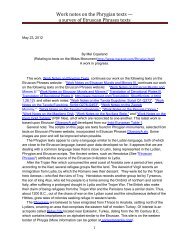Work notes on Etruscan Mirrors and Murals, Part I â - maravot.com
Work notes on Etruscan Mirrors and Murals, Part I â - maravot.com
Work notes on Etruscan Mirrors and Murals, Part I â - maravot.com
- No tags were found...
Create successful ePaper yourself
Turn your PDF publications into a flip-book with our unique Google optimized e-Paper software.
<str<strong>on</strong>g>Work</str<strong>on</strong>g> <str<strong>on</strong>g>notes</str<strong>on</strong>g> <strong>on</strong> <strong>Etruscan</strong> <strong>Mirrors</strong> <strong>and</strong> <strong>Murals</strong>, <strong>Part</strong> I —a survey of <strong>Etruscan</strong> Phrases textslinen <strong>and</strong> put away safely in the hut. Round the pyre they set up a circle of st<strong>on</strong>e slabs tomark the outside limit, <strong>and</strong> shoveled earth within.The ancient myths, such as you see recorded by Ovid in Metamorphosis, recount how men <strong>and</strong>women <strong>and</strong> gods <strong>and</strong> goddesses changed into animals, trees <strong>and</strong> st<strong>on</strong>es. Even rocks had life,such as the clanging rocks guarding the Hellesp<strong>on</strong>t through which Jas<strong>on</strong> <strong>and</strong> the Arg<strong>on</strong>auts hadto navigate. As a ship would be passing between them, suddenly the rocks would closetogether, crushing the ship <strong>and</strong> all of its passengers. The Iliad's details <strong>on</strong> the barrows <strong>and</strong>traditi<strong>on</strong>s of the Trojans <strong>and</strong> Greeks also refer to the st<strong>on</strong>es as having life to them. One group ofst<strong>on</strong>es menti<strong>on</strong>ed in the Iliad involves a council of the elders who sat up<strong>on</strong> "polished st<strong>on</strong>es."When looking up<strong>on</strong> a st<strong>on</strong>e circle <strong>and</strong> ancient tumuli, picture if you will King Agamemn<strong>on</strong> <strong>and</strong>his allies in council with regard to the c<strong>on</strong>duct of the war against the Trojans, for it may be thatHector's proposal to the Achaeans was in a st<strong>on</strong>e circle. Njal's Saga, a late 13th centurychr<strong>on</strong>icle from Icel<strong>and</strong>, records a similar court before what is called the "Law Rock." Each year aspecial court, called the Althing, was held at the "Law Rock” to judge disputes, divorces etc. Thesaga records a period during which Icel<strong>and</strong>ic family disputes produced many battles <strong>and</strong>revenge-killings. The disputes were resolved at the "Law Rock," in a manner similar to thatrecorded in the Iliad two thous<strong>and</strong> years earlier.Listen to the bard's quote of Hector:Iliad, Book VII: "Hear me speak, Trojans <strong>and</strong> Achaians both, <strong>and</strong> let me tell you what isin my mind. Cr<strong>on</strong>idês thr<strong>on</strong>ed <strong>on</strong> high would not let us keep our sworn treaty; but heordains a hard struggle for us all, until either you shall take the castle of Troy, or youshall be vanquished yourselves beside your own ships. Here am<strong>on</strong>g you if any <strong>on</strong>e ofyou has a mind to fight with me, let him <strong>com</strong>e forth, <strong>and</strong> be your champi<strong>on</strong> againstHector."Here is what I propose, <strong>and</strong> let Zeus be witness <strong>on</strong> both parts: if that man shall strike medown, let him strip me <strong>and</strong> take my armor for his spoil; but my body he shall give back tobe carried home, that my people may give me dead my porti<strong>on</strong> of fire. But if Apollo grantme success, <strong>and</strong> I strike him down, I will strip off his armor <strong>and</strong> take it into sacred Troy,<strong>and</strong> hang it before the temple of Apollo Shootafar; but the body I will give back, that hisfriends may carry it to their camp, to give him funeral <strong>and</strong> build him a barrow beside thebroad Hellesp<strong>on</strong>t. Then men will say in far distant generati<strong>on</strong>s to <strong>com</strong>e, as they sailal<strong>on</strong>g the shore, 'Y<strong>on</strong>der is the barrow of a man dead l<strong>on</strong>g ago, a champi<strong>on</strong> whomfamous Hector slew.' So my fame will never be forgotten."<strong>Etruscan</strong> heroes <strong>and</strong> gods also followed descripti<strong>on</strong>s seen in the Iliad. The Iliad is at least as oldas the <strong>Etruscan</strong> scripts, which date as early as 600 B.C. But its traditi<strong>on</strong> offers an earlier datewhich would be about 1,200 B.C., the time of the domini<strong>on</strong> of Mycenae, before the end of theHittite Empire, circa. 1,180 B.C. The s<strong>on</strong>s of the patriarch, Atreus, who were King Agamemn<strong>on</strong><strong>and</strong> his brother, Prince Menelaus, were c<strong>on</strong>sidered the supreme kings of the Achaeans at that8






